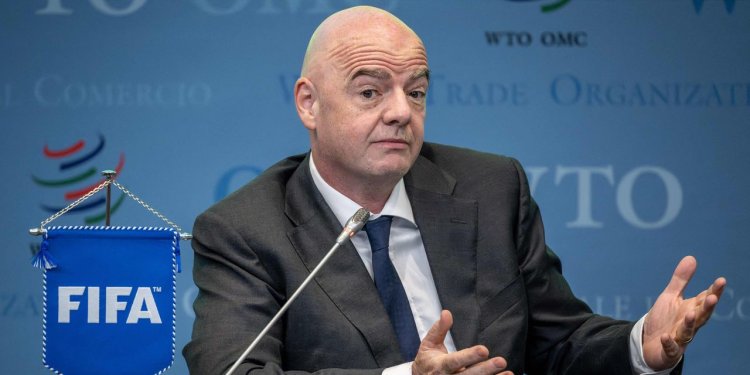FIFA President Threatens Not to Broadcast Women’s World Cup in Europe
‘To be very clear, it is our moral and legal obligation not to undersell the FIFA Women’s World Cup,’ FIFA president Gianni Infantino said. Photo: fabrice coffrini/Agence France-Presse/Getty Images By Rachel Bachman May 2, 2023 11:47 am ET For much of the 32-year existence of the Women’s World Cup, FIFA distributed the broadcast rights to the event like a “buy one, get one free” promotion: If broadcasters bought the rights for the men’s World Cup, they also got the rights to the Women’s World Cup. After the 2019 Women’s World Cup drew more than 1 billion global viewers, FIFA began a years-long transition to charging broadcasters a separate fee for the women’s tournament, in line with the event’s audiences. Less than three months before the July kickoff of the 2023 World Cup in A


‘To be very clear, it is our moral and legal obligation not to undersell the FIFA Women’s World Cup,’ FIFA president Gianni Infantino said.
Photo: fabrice coffrini/Agence France-Presse/Getty Images
For much of the 32-year existence of the Women’s World Cup, FIFA distributed the broadcast rights to the event like a “buy one, get one free” promotion: If broadcasters bought the rights for the men’s World Cup, they also got the rights to the Women’s World Cup.
After the 2019 Women’s World Cup drew more than 1 billion global viewers, FIFA began a years-long transition to charging broadcasters a separate fee for the women’s tournament, in line with the event’s audiences.
Less than three months before the July kickoff of the 2023 World Cup in Australia and New Zealand, however, FIFA hasn’t struck deals with broadcasters in some of Europe’s biggest countries and its president, Gianni Infantino, has made a series of intensifying complaints that the organization is being lowballed.
On Monday, Infantino went so far as to threaten not to sell the tournament’s rights at all in the “big five” European countries of England, Germany, France, Spain and Italy. He hasn’t identified which broadcasters FIFA is negotiating with in any of the countries.
“To be very clear, it is our moral and legal obligation not to undersell the FIFA Women’s World Cup,” Infantino said Monday during a panel discussion on women’s trade at the World Trade Organization headquarters in Geneva. “Therefore, should the offers continue not to be fair (toward women and women’s football), we will be forced not to broadcast the FIFA Women’s World Cup into the ‘Big 5’ European countries.”
Yet Infantino also acknowledged that FIFA’s predicament is partly due to FIFA itself training broadcasters to expect the women’s event for free.
“So, it’s our fault as well,” he said. “‘Please buy [the TV rights to] the Men’s World Cup [and] on top [of that], we will give you [the TV rights for] the Women’s World Cup kind of for free,’ right?”
The current battle is only a warm-up for future years. In many other countries around the world the rights remain bundled in this cycle and aren’t up for bid separately. Most notably, Fox is still operating under a bundled rights deal for the U.S. English-language rights to the men’s and women’s World Cups through 2026. The 2027 women’s tournament rights will be bid separately in the U.S.
Infantino’s complaints about the offers FIFA is fielding echoed his comments from mid-March at the FIFA Congress in Kigali, Rwanda. There, he announced a sharp increase in prize money for the Women’s World Cup—from a total pool of $30 million in 2019 to $110 million this year. He also dangled a lofty goal: equalizing prize money for the men’s and women’s World Cups by 2026-27. At the 2022 men’s World Cup in Qatar, total prize money was $440 million.
Infantino linked the notion of equal prize money with broadcasters paying more for rights to the Women’s World Cup, although he stopped short of naming a target revenue amount. FIFA projects the 2023 Women’s World Cup will generate more than $300 million in broadcast-rights fees, according to a person familiar with the situation. That includes estimates of the women’s portion of deals bundled with the men’s World Cup.

England and Sweden played in the third place match at the 2019 Women’s World Cup.
Photo: Xiao Yijiu/Zuma Press
On Monday, Infantino ticked off the amounts the “big five” European countries paid for the men’s World Cup rights: from just under $100 million for the rights in Spain to $100 million-$200 million for each of the other four countries. He said broadcasters in those countries offered 10 to 100 times less for the Women’s World Cup rights even though, he said, the women’s event drew 50-60% of the men’s viewership. He didn’t specify which tournament years he was comparing.
Infantino acknowledged that Women’s World Cup kickoff times in Australia and New Zealand would mean game broadcasts at 9 or 10 a.m. in Europe, but added that those times shouldn’t be an excuse for the low offers. FIFA has projected that 2 billion people worldwide will watch the 2023 Women’s World Cup. It estimates that 5 billion people watched the 2022 men’s World Cup in Qatar.
As he has in the past, Infantino painted himself as a changemaker working against history. He said that he has four daughters, and that when he took over as FIFA president in 2016, one of his first actions was to create a women’s football division.
“It took us over 100 years to do it, but we did it in the first few months after my election,” he said.
Write to Rachel Bachman at [email protected]
What's Your Reaction?













